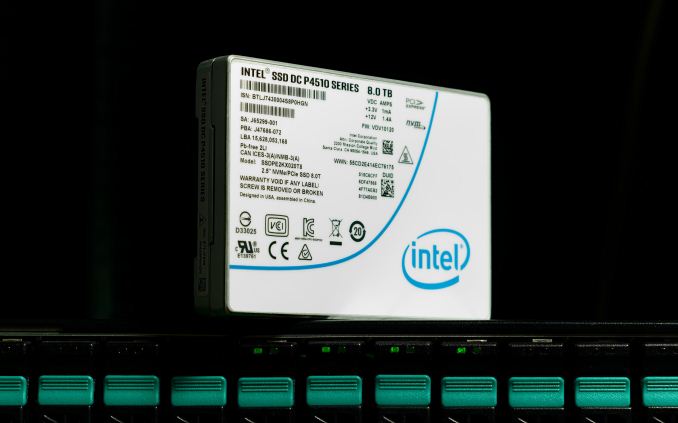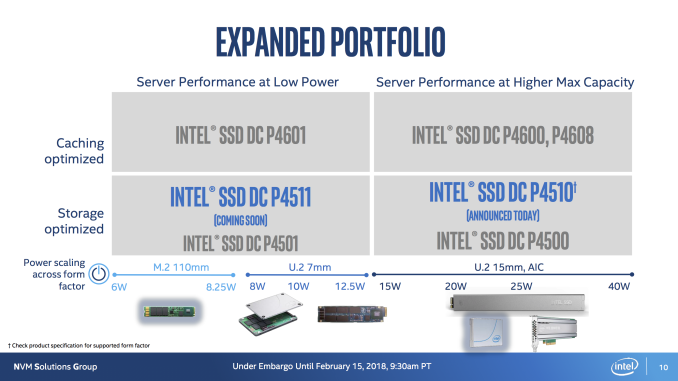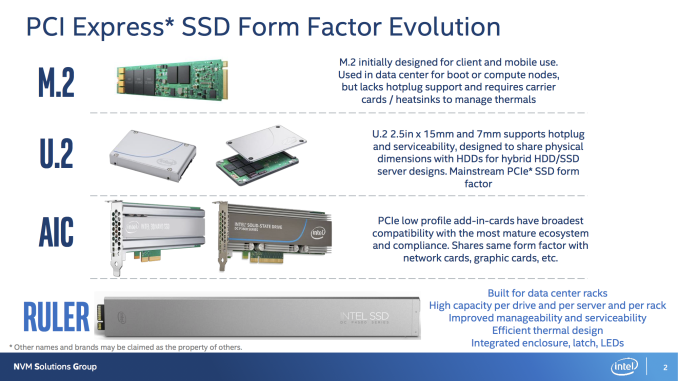The Intel SSD DC P4510 SSD Review Part 1: Virtual RAID On CPU (VROC) Scalability
by Billy Tallis on February 15, 2018 3:00 PM EST- Posted in
- SSDs
- Storage
- Intel
- RAID
- Enterprise SSDs
- NVMe
- U.2
- Purley
- Skylake-SP
- VROC

Today, Intel is introducing their 64-layer 3D TLC NAND to the enterprise SSD market with the new Intel SSD DC P4510 NVMe drive. They are also finally giving us a chance to test the Virtual RAID On CPU feature introduced with the Skylake-SP and Skylake-X processors last year. Intel has provided four 2TB P4510 SSDs to test against the 8TB model, plus the much sought-after VROC Premium hardware key to unlock the full range of NVMe RAID features on this platform.
The Intel SSD DC P4510 is Intel's first enterprise SSD to use their 64-layer 3D NAND flash memory. The P4510 uses the same second-generation Intel NVMe SSD controller as the other P45xx and P46xx drives introduced last year with 32-layer 3D NAND. With the Optane SSD DC P4800X now covering the highest product segment, Intel's flash-based enterprise NVMe drives are now divided into just two performance and endurance tiers. The P4510 falls into the cheaper tier of drives with much lower write performance and write endurance ratings that are generally between 0.5 drive writes per day (DWPD) and 1 DWPD. The DC P46xx tier has write endurance ratings around 3 DWPD (and the Optane SSD DC P4800X is rated for 30 DWPD).
Intel regards the P45xx tier of products as intended for high-capacity primary storage usage, while the P46xx drives are targeted for use as a cache layer. With their second-generation NVMe controller, Intel is also dividing their enterprise NVMe SSD family on another axis. Unlike the controller used on the P3xxx series, new controller is small enough to fit on a M.2 card, and can operate within the power limits of that form factor. A month after first announcing the P4500 and P4600, Intel introduced the low-power P4501 as their first M.2 drive with an in-house controller. The P4501 is also available as a 7mm thick U.2 drive, compared to the 15mm thickness of the high-power U.2 drives. The P4510 falls into that high-power category, but the smaller capacities are rated for just 10W active power, which is comparable to the 2.5" version of the P4501.
| Intel SSD DC P4510 Specifications | |||||
| Capacity | 1 TB | 2 TB | 4 TB | 8 TB | |
| Form Factor | 2.5" 15mm U.2 | ||||
| Interface | PCIe 3.1 x4 NVMe 1.2 | ||||
| Memory | Intel 512Gb 64-layer 3D TLC | ||||
| Sequential Read | 2850 MB/s | 3200 MB/s | 3000 MB/s | 3200 MB/s | |
| Sequential Write | 1100 MB/s | 2000 MB/s | 2900 MB/s | 3000 MB/s | |
| Random Read | 469k IOPS | 624k IOPS | 625.5k IOPS | 620k IOPS | |
| Random Write | 72k IOPS | 79k IOPS | 113.5k IOPS | 139.5k IOPS | |
| Maximum Power | Active | 10 W | 10 W | 14 W | 16 W |
| Idle | 5 W | 5 W | 5 W | 5 W | |
| Write Endurance | 1.1 DWPD | 0.7 DWPD | 0.9 DWPD | 1.0 DWPD | |
| Warranty | 5 years | ||||
Compared to the Intel SSD DC P4500, the biggest performance gains the P4510 brings are to write speeds. Random write performance is more than doubled, and sequential write performance is 60-90% higher. With those performance increases and the reduced power consumption, the Intel claims the P4510 offers twice the performance per watt on some workloads.
Intel has also tuned the P4501's firmware to offer much better quality of service. A major part of this is that the P4510 is better about prioritizing read operations over flash program or erase operations, leading to an order of magnitude improvement in 99.99th percentile read latency. The P4510 also benefits from the 64L 3D TLC's flash program latency, which is about half that of Intel's 32L 3D NAND.
While today marks the first official announcement of the P4510, the 1TB and 2TB capacities started shipping to some large cloud providers in 2017. New today are the 4TB and 8TB models, and the full line will be more broadly available starting this quarter. With a broad range of capacities, and lower prices and higher performance enabled by the transition to 64L 3D NAND, Intel is expecting the P4510 to be their best-selling SSD this year. For now, the P4510 is only available as a 2.5" U.2 drive, but in the future Intel may introduce other form factors, including EDSFF—the now-standardized version of the Intel Ruler concept.
We have only had a few days to play with the Intel SSD DC P4510 and Intel VROC, so the benchmark results in this review are very limited. This review focuses solely on the performance of the P4510 and the scalability limits of Intel VROC. Follow-up reviews will provide our usual in-depth analysis of single-drive performance and power efficiency as compared against other enterprise NVMe SSDs, compare VROC performance between Windows and Linux, and VROC performance with an Optane cache. We will also test VROC with our client SSD test suite and Samsung 960 PRO consumer SSDs.












21 Comments
View All Comments
ABB2u - Thursday, February 15, 2018 - link
Is Intel VROC really software RAID? No question RAID is all about software. But, since this is running underneath an OS at the chip level why not call it Hardware RAID just like the RAID software running on an Avago RAID controller? In my experience, I have referred to software RAID as that implemented in the OS through LVM or Dsik Management, the filesystem like ZFS, or erasure encoding at a parallel block level. --- It is all about the difference in latency.saratoga4 - Thursday, February 15, 2018 - link
>Is Intel VROC really software RAID?Yes.
> In my experience, I have referred to software RAID as that implemented in the OS
That is what VROC is. Without the driver, you would just have independent disks.
Samus - Thursday, February 15, 2018 - link
So this is basically just storagespaces?tuxRoller - Friday, February 16, 2018 - link
Storage Space is more similar to lvm & mdadm (pooling, placement & parity policies, hot spares, and a general storage management interface) while vroc lets the os deal with nvme device bring up & then offers pooling + parity without an hba.HStewart - Thursday, February 15, 2018 - link
I would think any raid system has software to drive - it maybe on say an ARM microcontroller - but it still has some kind of software to make it work.But I would doubt if you can take Intel's driver and make it work on another SSD. It probably has specific hardware enhancements to increase it's performance.
Nime - Thursday, March 21, 2019 - link
If RAID controller uses the same CPU as OS it might be called soft. If the controller has its own processor to calculate disk data to read & write, it's a hard raid system.saratoga4 - Thursday, February 15, 2018 - link
I would be interested to see performance of normal software raid vs. VROC since for most applications I would prefer not to boot off of a high performance disk array. What, if any, benefit does it offer over more conventional software raid?JamesAnthony - Thursday, February 15, 2018 - link
I think the Raid 5 tests when you are done with them are going to be an important note in what the actual performance the platform is capable of.boeush - Thursday, February 15, 2018 - link
Maybe a stupid question, but - out of sheer curiosity - is there a limit, if any, on the number of VROC drives per array? For instance, could you use VROC to build a 10-drive RAID-5 array? (Is 4 drives the maximum - or if not, why wouldn't Intel supply more than 4 to you, for an ultimate showcase?)On a separate note - the notion of paying Intel extra $$$ just to enable functions you've already purchased (by virtue of them being embedded on the motherboard and the CPU) - I just can't get around it appearing as nothing but a giant ripoff. Doesn't seem like this would do much to build or maintain brand loyalty... And the notion of potentially paying less to enable VROC when restricted to Intel-only drives - reeks of exerting market dominance to suppress competition (i.e. sounds like an anti-trust lawsuit in the making...)
stanleyipkiss - Thursday, February 15, 2018 - link
The maximum number of drives, as stated in the article, depends solely on the number of PCI-E lanes available. These being x4 NVME drives, the lanes dry up quickly.